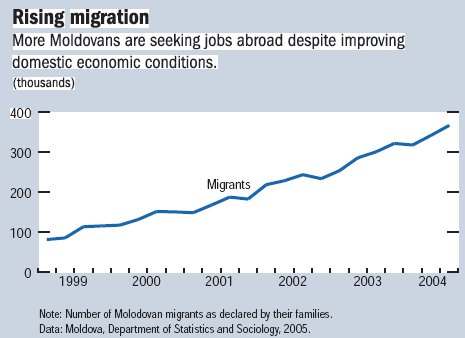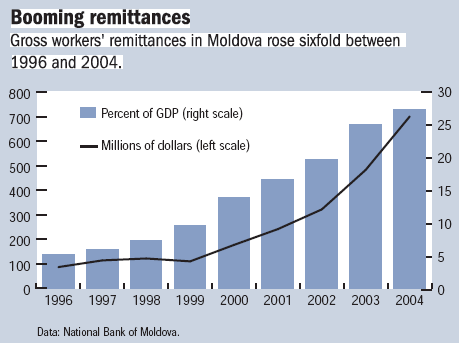Vol. 35, no. 3, page 40
Country
focus
Building a
better future at home: remittances in Moldova
In today’s world, economic integration goes beyond
international trade and capital movements and increasingly involves
the movement of labor, too. A case in point is
Moldova, where large-scale labor emigration and remittance flows
have played a dominant role in shaping the country’s recent economic
evolution. A new IMF Special Issues paper takes a closer look at the
kinds of policies that would allow Moldova to maximize the benefits
of its remittance inflows.
After the collapse of the former Soviet Union, Moldova began a
profound transformation as it moved from a centrally planned to a
more market-based economy. The resulting
dislocations led to a sharp contraction in output and massive job
losses. These were compounded in 1998, when the shock waves from the
Russian financial crisis hit Moldova particularly hard because of
the strong trade links between the two countries. As Russia’s
domestic demand collapsed, Moldova’s exports to the countries of the
former Soviet Union—the destination for two-thirds of its exports—
declined by 50 percent in the second half of 1998 compared with the
same period in 1997. The cumulative GDP loss reached 10 percent
between 1997 and 1999, and it is estimated
that the poverty rate rose sharply, to over 70 percent by 1999 from
47 percent in 1997.
With few viable options at home, many workers were forced to seek
job opportunities outside Moldova to support their families. Between
1998 and 2000, the number of Moldovans working abroad doubled, and
remittances rose from $122 million to $172 million. In turn, these
inflows, by providing an important supplement to household
disposable incomes, helped accelerate a subsequent domestic recovery.

What is striking about Moldova’s experience to date is that
migration has persisted even after the domestic economy recovered
strongly (see chart). Since 2000, Moldova’s
domestic economy has shown marked improvement, with GDP rising by a
cumulative 30 percent by 2004. Nonetheless, migration and
remittances have continued to intensify, with
new migrants benefiting from the informal support of a growing
expatriate community. In 2004, official estimates put the total
gross inflows of workers’ remittances at $700 million,
almost 27 percent of GDP (see chart, right)—high in comparison even
with other countries with significant remittances. At the same time,
Moldova’s gross national disposable income per capita—a measure that
includes net income and transfers from abroad—more than doubled
between 2000 and 2004, reaching close to $1,000. In addition, the
country’s poverty rate declined from its peak of 73 percent in 1999
to
about 26 percent by 2004.

Large and stable inflows
At end-2004, Moldovan migrant workers, both temporary and
permanent, accounted for about 17 percent of Moldova’s total
population. They send large portions of their earnings home, which
their families have used chiefly to meet their basic consumption
needs and to finance housing and education, investing smaller
amounts in business activities. As is common in other countries that
receive remittances, Moldova’s remittance inflows are likely to
remain a stable and countercyclical source of foreign exchange in
the short run. And, as more migrants settle abroad permanently,
portfolio choice considerations may become more important.
Migration and remittances have important macroeconomic
consequences, too. They drive growth through household consumption;
reduce the labor supply and put pressure on wages; finance a large
and widening trade deficit; put pressure on the exchange rate to
appreciate; fuel inflationary pressures; contribute to higher tax
revenues, particularly through higher value-added tax collection on
rising imports; and threaten the sustainability
of the pension system.
Indeed, the study’s microeconomic survey confirms that households
spend most of their supplemental income on consumer goods and
housing construction. This spending has provided a strong short-term
boost to domestic demand that has helped drive GDP growth in recent
years. Ultimately, however, ensuring sustainable growth will require
a more balanced composition of aggregate demand—with a greater
contribution from
business investment in particular.
Policy choices are critical
In Moldova’s public debate, the issues of migration and remittances
have tended to be framed in terms of good or bad. For the longer
term, however, what matters more are
the underlying reasons for these phenomena and the policy response.
In principle, the greater mobility of capital and labor permits a
more efficient allocation of resources. In that sense, a wider
choice of employment opportunities, both at home and abroad, for
Moldova’s workers is welcome. At the same time, policy choices in
three broad areas—fiscal, monetary, and structural—become critical
for maximizing the potential benefits of labor migration and
remittances.
For fiscal policy, Moldova’s key short-term challenge is
to help safeguard macroeconomic stability and resist procyclical
spending temptations in the face of surging tax revenues. Reduced
unemployment and improved household incomes from higher wages and
transfers from abroad ease social spending pressures. Over the
longer term, considerations of fiscal sustainability become critical,
as the government grapples with shifts in the demographic structure
through the loss of some of its economically active population. At
present, the pay-as-you-go pension system, which relies on
contributions from the current generation of workers to finance
retirement benefits for current retirees, is coming under pressure,
as the exodus of workers reduces the base on which the contributions
are levied.
Monetary policy has a key role to play in creating a
stable macroeconomic environment, but it needs greater support from
fiscal and structural policies to be effective. At this point, a
strategy geared to maintaining a flexible exchange rate regime,
paired with
a clear focus on low inflation as the overriding goal of monetary
policy, appears to be a reasonable option. Improving and maintaining
external competitiveness are inextricably
linked to the over-riding policy challenge of accelerating economic
development. In that sense, competitiveness should be viewed not
only in terms of safeguarding external sustainability but also in
terms of Moldova’s ability to build solid economic growth by
attracting much-needed foreign direct investment.
On the structural side, the short-term benefits of
remittances for the domestic economy should not be allowed to
obscure the need to implement an effective structural reform
agenda. Moldova’s problem today is that much of the impetus to
migrate stems from the lack of opportunities at home. In the end,
only by making Moldova a more attractive place for both labor and
capital can the government ensure that its resources—most important,
the skills and talent of its population—will be used to their full
potential for the benefit of present and future generations. A
determined and sustained effort to improve the business environment
would enhance Moldova’s attractiveness as a destination for foreign
capital and stimulate larger foreign direct investment inflows,
which have been relatively modest to date. It would also create
incentives that would help channel migrant remittances increasingly
toward productive uses. This aspect will assume greater importance
over time because more migrants are likely to work abroad
permanently and consider investing their savings in their host
country.
* Note: the content of this paper is not
available on the website, but some parts of it can be
found in the IMF Country Report No.05/54 "Republic of Moldova: Selected
Issues" chapters 1 (Macroeconomic Consequences of Workers’ Remittances in
Moldova) and 2 (Migration and Remittances—A Micro Perspective). This report
can be downloaded from here
|